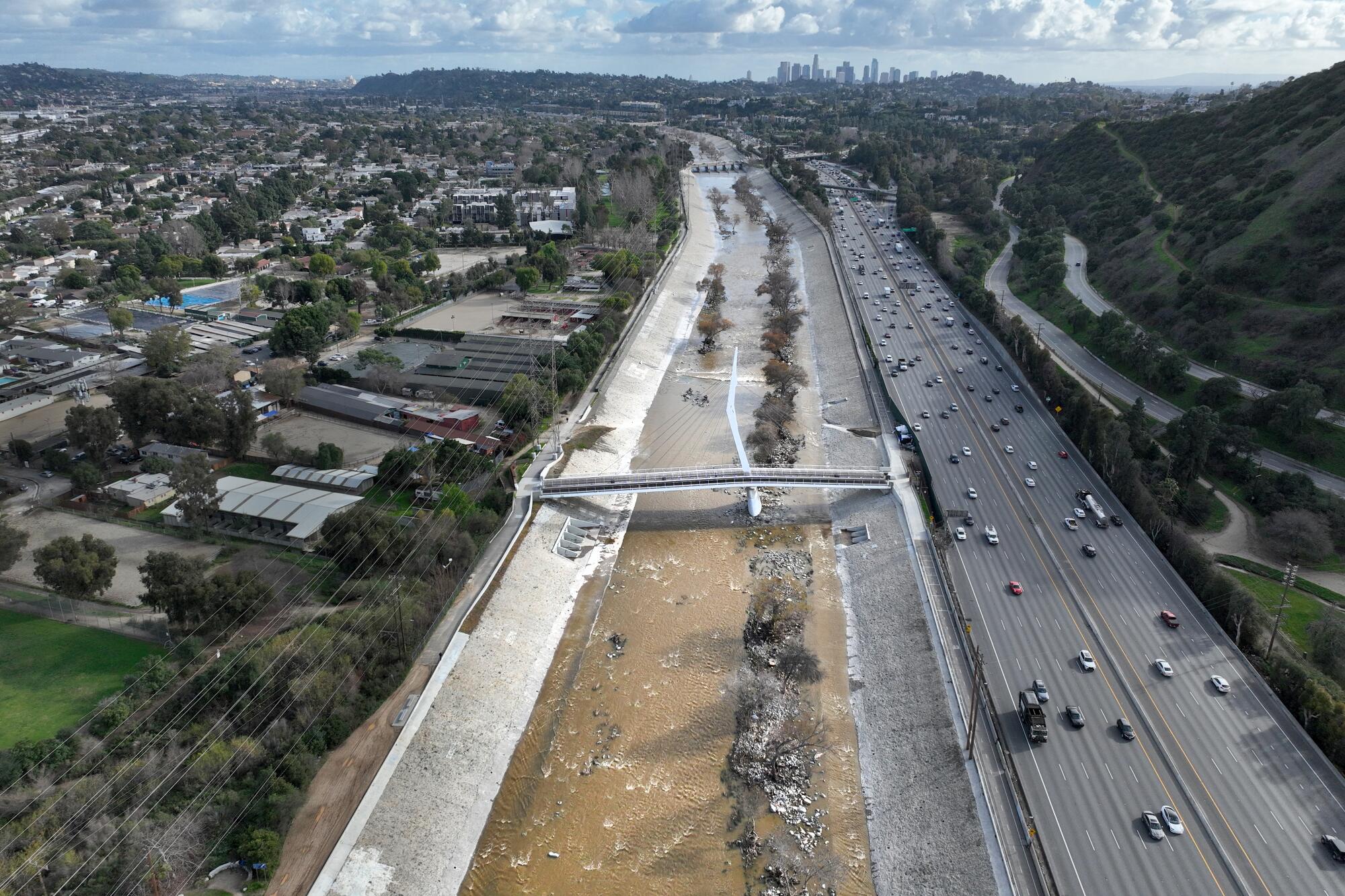
- Share via
Heavy rains this winter and spring sent torrential flows down local creeks and rivers, and L.A. County managed to capture and store a significant amount of that stormwater, officials say.
To be exact, they snared an estimated 295,000 acre-feet of water since last October, or 96.3 billion gallons.
That’s enough water to supply about 2.4 million people a year — nearly one-fourth of the county’s population.
“This year has really been a super year,” said Mark Pestrella, director of L.A. County Public Works.
Aggressive and impactful reporting on climate change, the environment, health and science.
The county, working with the Los Angeles Department of Water and Power and other agencies, was able to capture and store this amount of water thanks in part to investments totaling more than $1 billion since 2001, Pestrella said. Some of the money has gone toward raising dams and increasing the capacity of spreading grounds, where water is sent into basins and then percolates underground into aquifers.
“Our investments are paying off,” Pestrella said.
The county has also spent more than $1 billion since 2001 on removing sediment from reservoirs to ensure their water-catching capacity isn’t diminished.
A large portion of the funds have come from the L.A. County Flood Control District, which receives revenues from property taxes.
Money for stormwater-catching infrastructure has also come through the Safe, Clean Water Program, which was established after county voters passed Measure W in 2018.
Though the amount of runoff captured since October has been substantial, the county’s facilities took in more water during the major storms over the previous 12 months — an estimated 626,000 acre-feet, or enough to supply about 5 million residents for a year.
The last two wet seasons have dumped exceptional amounts of rain, approaching the record set between 1888 and 1890.
The runoff has collected behind 14 county dams and flowed downstream to spreading grounds that recharge groundwater at 27 county-operated facilities. Much of the water collected over the past winter is now banked underground.
Not only does the captured rain add to the supplies of local cities, it’s much cheaper than importing water from Northern California or the Colorado River.
Storm runoff that doesn’t get captured flows into the Pacific Ocean via the San Gabriel and Los Angeles rivers, as well as other waterways.
Capturing more stormwater and reducing reliance on imported water are among the main goals of L.A. County’s water plan, which the Board of Supervisors adopted in December.
The L.A. County Board of Supervisors has adopted the county’s first water plan, which outlines how the region must stop importing 60% of its water by 2045.
County officials developed the plan to make the region more resilient to the effects of climate change, including more severe droughts as well as storms that are projected to unleash more intense downpours. By 2045, the plan calls for L.A. County to become 80% reliant on local water supplies by capturing more stormwater, recycling wastewater and boosting conservation.
“We know with weather volatility, we have to save every drop of water that we can. So this has to continue to be a trend that we invest in,” said Lindsey P. Horvath, chair of the Board of Supervisors.
Horvath said she was pleased to see the amount of rainwater captured, and that the county’s plan lays out a path for taking advantage of downpours when they come.
“The more we see investment in infrastructure, the more we’re going to be able to capture and make a difference, and keep that water resource local.”
Officials at the L.A. Department of Water and Power said the agency captured about 99,000 acre-feet of stormwater between Oct. 15 and April 15 — a portion of that through joint efforts with the county.
That included more than 12,200 acre-feet of stormwater that flowed into the city’s Tujunga Spreading Grounds, which was expanded in a project completed in 2022.
“We’ve been really building capacity to catch major storm flows,” said Martin Adams, the DWP’s general manager. “The fact that we actually caught more is directly the result of the efforts that the water agencies have made locally to grab that water before it gets to the ocean.”
Since 2008, the DWP has invested more than $130 million in stormwater infrastructure projects.
City officials plan to further boost local water supplies by investing in more stormwater capture, as well as recycling wastewater and cleaning up contaminated groundwater in the San Fernando Valley.
Projects that divert storm runoff for storage underground make economic sense, Adams said.
“If we put water in the ground, it makes us more drought-proof, it makes us more resilient,” Adams said. “We’re going to have a much bigger portion of the city’s water supply right here under our old feet.”
Pestrella said L.A. County officials are working toward a goal of doubling the area’s stormwater capture capacity.
Current conditions are promising, but L.A. must maintain its ethos of conservation and prepare for an inevitable return to dry times ahead, LADWP officials say.
Environmental advocates have supported efforts to harness more runoff, recycle water and lessen reliance on supplies from the Sacramento-San Joaquin River Delta and the depleted reservoirs of the Colorado River.
The amount of water captured this year represents a significant step forward, said Conner Everts, executive director of the Southern California Watershed Alliance.
“It’s impressive how much more we’ve done now with the projects that have been in play in the last five to 10 years,” Everts said. “We have to be more reliant on local water supplies, and we have a great potential to continue to do that.”
Toward a more sustainable California
Get Boiling Point, our newsletter exploring climate change, energy and the environment, and become part of the conversation — and the solution.
You may occasionally receive promotional content from the Los Angeles Times.








